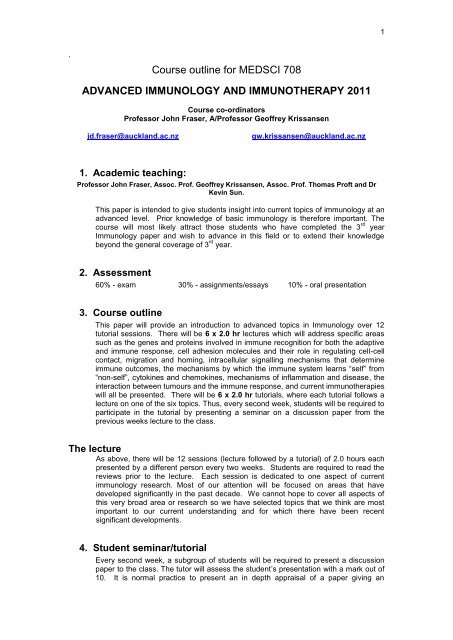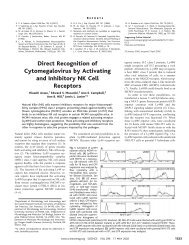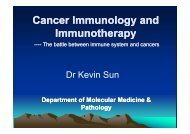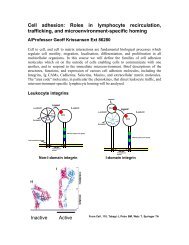Course Outline
Course Outline
Course Outline
Create successful ePaper yourself
Turn your PDF publications into a flip-book with our unique Google optimized e-Paper software.
1<br />
`<br />
<strong>Course</strong> outline for MEDSCI 708<br />
ADVANCED IMMUNOLOGY AND IMMUNOTHERAPY 2011<br />
<strong>Course</strong> co-ordinators<br />
Professor John Fraser, A/Professor Geoffrey Krissansen<br />
jd.fraser@auckland.ac.nz<br />
gw.krissansen@auckland.ac.nz<br />
1. Academic teaching:<br />
Professor John Fraser, Assoc. Prof. Geoffrey Krissansen, Assoc. Prof. Thomas Proft and Dr<br />
Kevin Sun.<br />
This paper is intended to give students insight into current topics of immunology at an<br />
advanced level. Prior knowledge of basic immunology is therefore important. The<br />
course will most likely attract those students who have completed the 3 rd year<br />
Immunology paper and wish to advance in this field or to extend their knowledge<br />
beyond the general coverage of 3 rd year.<br />
2. Assessment<br />
60% - exam 30% - assignments/essays 10% - oral presentation<br />
3. <strong>Course</strong> outline<br />
This paper will provide an introduction to advanced topics in Immunology over 12<br />
tutorial sessions. There will be 6 x 2.0 hr lectures which will address specific areas<br />
such as the genes and proteins involved in immune recognition for both the adaptive<br />
and immune response, cell adhesion molecules and their role in regulating cell-cell<br />
contact, migration and homing, intracellular signalling mechanisms that determine<br />
immune outcomes, the mechanisms by which the immune system learns “self” from<br />
“non-self”, cytokines and chemokines, mechanisms of inflammation and disease, the<br />
interaction between tumours and the immune response, and current immunotherapies<br />
will all be presented. There will be 6 x 2.0 hr tutorials, where each tutorial follows a<br />
lecture on one of the six topics. Thus, every second week, students will be required to<br />
participate in the tutorial by presenting a seminar on a discussion paper from the<br />
previous weeks lecture to the class.<br />
The lecture<br />
As above, there will be 12 sessions (lecture followed by a tutorial) of 2.0 hours each<br />
presented by a different person every two weeks. Students are required to read the<br />
reviews prior to the lecture. Each session is dedicated to one aspect of current<br />
immunology research. Most of our attention will be focused on areas that have<br />
developed significantly in the past decade. We cannot hope to cover all aspects of<br />
this very broad area or research so we have selected topics that we think are most<br />
important to our current understanding and for which there have been recent<br />
significant developments.<br />
4. Student seminar/tutorial<br />
Every second week, a subgroup of students will be required to present a discussion<br />
paper to the class. The tutor will assess the student’s presentation with a mark out of<br />
10. It is normal practice to present an in depth appraisal of a paper giving an
2<br />
overview of the area that it addresses, the question it tackles, any hypotheses that<br />
are tested, the methods used, the results achieved and of course the interpretation of<br />
the data and conclusions about how this paper has advanced to field. Please note: It<br />
is essential to present the actual figures of the article (main figures at least) so<br />
that your audience can judge the credibility of the results. The preferred medium<br />
is powerpoint files which will be displayed using our datashow projector (see<br />
description of Discussion papers below). Most students choose to use a PowerPoint<br />
presentation, but you must let the tutor know ahead of time, and provide the files<br />
before the day of presentation.<br />
5. Essay<br />
A 3000-word essay on one of the six course topics. You may wish to discuss the<br />
scope of your essay with the lecturer before you begin writing. Essays are to be<br />
submitted to the Departmental Secretary by 5:00pm Friday 10 th June 2011.<br />
Extensions must be requested in writing to the course coordinators. This is almost<br />
two weeks after the final tutorial session and should give you sufficient time to<br />
concentrate on your exam.<br />
6. Assignment of papers and essays<br />
At the beginning of the course, we will arbitrarily assign you to one or more discussion<br />
papers. The number you are assigned will depend on how many students we have in<br />
the course each year but will likely be one, and no more than two. You may<br />
“negotiate” with other students if you wish to change your time or topic but must let<br />
the course coordinators know of any changes.<br />
Several essay topics will be provided and you can choose a 1,2,3 priority. This will be<br />
done in the first session. This is in order to distribute students evenly across the<br />
essay topics<br />
7. Advice<br />
The following facilities are available to you in the Division:<br />
Tearooms-<br />
level 3 Clinical Building<br />
Photocopiers- level 3 Pathology Building 504<br />
level 3 Clinical Building<br />
Please note that the secretaries in the Department may be able to assist with photocopying,<br />
but that this is not a service which can be provided instantaneously. Please provide material<br />
well in advance.<br />
All teaching in MEDSCI 708 will be in Room 502-034.<br />
PDF copies of all articles selected for discussion will be placed on a website for you to read or<br />
print-off.<br />
Important<br />
The essay must be an original work of scholarship. Unacknowledged copying or plagiarism in<br />
completing this work is treated as an examination offence (see University Calendar).<br />
Word limit for the essay = 3,000 words.<br />
Any photocopying of presentation handouts must be done before the day of the presentation.<br />
The secretaries may not be able to photocopy materials on the day of the presentation.
3<br />
8. Review papers<br />
All students prior to the tutorial must read the review papers. Make notes about what<br />
you think are important points or questions you have to bring to the tutorial.<br />
9. Discussion papers – Presentations<br />
Discussion papers will be assigned to individual students who will be asked to present<br />
a 15 or 20 minute (depending on class numbers) oral synopsis of a discussion paper<br />
pointing out the significant aspects of the research and how the conclusions were<br />
reached. The presentation will be followed by 5 minutes of questions from the lecturer<br />
and class colleagues. Please note: It is essential to present the actual figures of<br />
the article (main figures at least) so that your audience can judge the credibility<br />
of the results. Assignments of names to discussion papers will be done at the<br />
beginning of the topic. All students should read the discussion papers and offer<br />
enlightened comments during the tutorial sessions. The tutor’s role is to ask<br />
questions pertinent to the subject and to fill in any gaps. A maximum of 10<br />
powerpoint slides will be allowed. Presentations must not be allowed to go over<br />
the allocated time (marks will be deducted).<br />
10. Final exam<br />
All material presented in the course is examinable.
4<br />
Lecture summaries<br />
Wednesday 8:00am – 10.00pm. Room 502-034.<br />
March 2nd and 9 th Topic 1- Antigen recognition in adaptive and<br />
innate immunity – John Fraser<br />
The immune response of higher organisms has two distinct but interlinked systems – the<br />
innate and adaptive response. The adaptive response uses a set of rearranging genes to<br />
create antibody and T cell Receptor molecules with a vast repertoire of antigen recognition<br />
surfaces. The innate response relies on a wide array of fixed pattern recognition receptors<br />
that bind to molecules only found on microbes. This session looks at both systems from the<br />
standpoint of antigen recognition; the types of molecules that are involved such as MHC and<br />
T cell Receptor and TLR and other innate receptors such as the intracellular inflammasome<br />
and their roles, and the way in which different types of antigens are recognised and cells are<br />
triggered. The session will also address one of the most compelling questions in<br />
immunology, how do these molecules distinguish small differences between self and non-self<br />
antigens from such small amounts of antigen? We hope by the end of this session, you will<br />
have an appreciation for the exquisite complexity and diversity of antigen recognition in both<br />
the adaptive and innate responses and how both work together to provide the means to<br />
discriminate and respond to pathogens.<br />
March 16 st and March 23 rd Topic 2- Cell adhesion: Roles in<br />
lymphocyte recirculation, trafficking, and microenvironmentspecific<br />
homing - Geoffrey Krissansen<br />
Cell to cell, and cell to matrix interactions are fundamental biological processes which<br />
regulate cell motility, migration, localisation, differentiation, and proliferation in all multicellular<br />
organisms. In this topic we will define the families of cell adhesion molecules that sit on the<br />
outside of immune cells enabling cells to move within tissues like primitive amoeba, to<br />
communicate with one another, and to respond to their immediate microenvironment. The<br />
structures, functions, and expression of various cell adhesion molecules involved in the latter<br />
processes, including the Integrins, Ig CAMs, Cadherins, Selectins, Mucins, and extracellular<br />
matrix molecules will be briefly addressed. The fascinating, “highly controlled” multistep<br />
process by which leukocytes extravasate from blood vessels will be explored. The "area<br />
code" molecules, in particular the chemokines, that direct leukocyte traffic, and<br />
microenvironment-specific lymphocyte homing will be analysed. By the end of the session you<br />
will understand how the efficiency of the immune system is increased by the<br />
immunolocalization of specialized leukocytes to sites in the body where they are most likely to<br />
find antigen, and/or enhance the immune response.<br />
March 30 th and 6 th April Topic 3- NK Receptors – John Fraser<br />
There are two very distinct pathways by which foreign peptides are generated and presented<br />
on the surface of cells in the context of MHC. The endogenous and exogenous pathways of<br />
antigen presentation will be discussed. Recent evidence has revealed that a number of<br />
pathogens selectively target elements of these pathways to prevent the immune system from<br />
recognising them reflecting the never ending battle between host and pathogen. Papers<br />
concerning these recent discoveries will be highlighted.<br />
April 27 th and May 4 th Topic 4- Antigen Presentation – Thomas<br />
Proft<br />
There are two very distinct pathways by which foreign peptides are generated and presented<br />
on the surface of cells in the context of MHC. The endogenous and exogenous pathways of<br />
antigen presentation will be discussed. Recent evidence has revealed that a number of<br />
pathogens selectively target elements of these pathways to prevent the immune system from
5<br />
recognising them reflecting the never ending battle between host and pathogen. Papers<br />
concerning these recent discoveries will be highlighted.<br />
May 11 th and 18 th Topic 5- Advances in understanding<br />
inflammatory disease – Geoffrey Krissansen<br />
Inflammation is normally a benign short-lived reaction mediated by vascular and immune<br />
systems, which is designed primarily to defend the body against invaders. Uncontrolled or<br />
chronic inflammation as seen in autoimmunity is abnormal and underlies the pathogenesis of<br />
many immune diseases. Therefore, understanding the mechanisms of inflammation and<br />
devising ways to prevent it are high priorities for biomedical research. In this topic we will<br />
explore how specific leukocyte types, cell adhesion molecules, chemokines, and cytokines<br />
contribute to the progression and severity of inflammatory-based diseases when the immune<br />
response goes awry. We will examine the roles of T regulatory cells (Tregs), fondly called the<br />
guardians of our immune system, and their unique relationship with certain integrins. We will<br />
touch on potential strategies to treat inflammatory disease.<br />
May 25 th and 1 st June Topic 6- Tumour Immunology – Kevin Sun<br />
Numerous immune effector cells and molecules participate in the recognition and destruction<br />
of cancer cells. But cancer cells can avoid such immunosurveillance. The interaction between<br />
the immune system and cancer cells determines the fortune of tumours. A plethora of<br />
different approaches to cancer immunotherapy are being now being trialed to combat solid<br />
tumours, with varying degrees of success. Cancer immunotherapy is providing unique<br />
insights into tumor immunology, and the properties of tumours that must be overcome if the<br />
human immune system is to be harnessed as a weapon to fight cancer. In this topic you will<br />
study some of the approaches being used, and will learn how tumours interact with, and avoid<br />
the immune response.
6<br />
Reference articles<br />
Papers in pdf format are available for download at http://cmb1.auckland.ac.nz/medsci708<br />
1. Recognition by the adaptive and innate immune system -<br />
John Fraser<br />
REVIEWS<br />
Germain RN 2004. An innately interesting decade of research in immunology Nature Medicine 10:<br />
1307-1320. This is a rich summary of the past 10 years’ discovery of the mechanisms for innate<br />
immune recognition written by a respected immunologist. It provides all the references to the key<br />
papers on several very active subjects.<br />
Cooper, M and Alder M (2006) The evolution of the innate and adaptive immune systems Cell 124<br />
815-822. This review covers the extraordinary process of evolution of antigen recognition from<br />
simply innate receptors to complex TcR and Ig molecules that rearrange.<br />
Shizuo Akira, Satoshi Uematsu and Osamu Takeuchi (2006) Pathogen Recognition and Innate<br />
Immunity Cell 124 783-80. An excellent overview of innate pattern recognition<br />
Fabio Martinon, Annick Mayor, Jürg Tschopp (2009) The Inflammasomes: Guardians of the Body<br />
Annual Review of Immunology, Vol. 27: 229-265 This is a recent review on the inflammasome an<br />
innate recognition system that responds to intracellular changes. It has been linked to chronic<br />
inflammatory diseases such as gout and type II diabetes.<br />
DISCUSSION PAPERS<br />
Stephanie C. Eisenbarth, Oscar R. Colegio, William O’Connor Jr, Fayyaz S. Sutterwala & Richard A.<br />
Flavell (2008) Crucial role for the Nalp3 inflammasome in the immunostimulatory properties of<br />
aluminium adjuvants Nature 453 1122-1126 This paper reveals the long sought after mechanism of<br />
the widely used adjuvant Alum; a compound used in most vaccines to enhance the B cell immune<br />
response to antigen.<br />
Oliver Schulz, Sandra S. Diebold, Margaret Chen, Tanja I. Naslund , Martijn A. Nolte1, Lena<br />
Alexopoulou, Yasu-Taka Azuma, Richard A. Flavell, Peter Liljestrom & Caetano Reis e Sousa (2005)<br />
Toll-like receptor 3 promotes cross-priming to virus-infected cells Nature 433: 887-891. This paper is<br />
a good example of how the adaptive and innate recognition work together to define the type of<br />
response to a viral infection and how important innate immunity is to an effective CD4/CD8 response<br />
to virus.<br />
Darrell J. Irvine, Marco A. Purbhoo, Michelle Krogsgaard, Mark M. Davis (2002) Direct observation<br />
of ligand recognition by T cells Nature 419 845-849 This paper was a landmark which used new<br />
imaging technology and fluorescent probes to actually measure how many peptides it takes to<br />
stimulate a T cells. The results were remarkable.<br />
2. Cell Adhesion and leukocyte trafficking - Geoff Krissansen<br />
REVIEW<br />
Salmi M, Jalkanen S (2005). Cell-surface enzymes in control of leukocyte trafficking. Nat Rev<br />
Immunol. 5:760-71.<br />
Ley K, Laudanna C, Cybulsky MI, Nourshargh S. Getting to the site of inflammation: the leukocyte<br />
adhesion cascade updated. Nat Rev Immunol. 7: 678-89, 2007.
7<br />
Sigmundsdottir H, Butcher EC. Environmental cues, dendritic cells and the programming of tissueselective<br />
lymphocyte trafficking. Nat Immunol. 9: 981-7, 2008.<br />
DISCUSSION PAPERS<br />
McDonald B, Pittman K, Menezes GB, Hirota SA, Slaba I, Waterhouse CC, Beck PL, Muruve DA,<br />
Kubes P. Intravascular danger signals guide neutrophils to sites of sterile inflammation. Science 330:<br />
362-6, 2010.<br />
Sigmundsdottir H, Pan J, Debes GF, Alt C, Habtezion A, Soler D, Butcher EC. (2007) DCs<br />
metabolize sunlight-induced vitamin D3 to 'program' T cell attraction to the epidermal chemokine<br />
CCL27. Nat Immunol. 8: 285-293.<br />
Mora JR, Iwata M, Eksteen B, Song SY, Junt T, Senman B, Otipoby KL, Yokota A, Takeuchi H,<br />
Ricciardi-Castagnoli P, Rajewsky K, Adams DH, von Andrian UH. (2006) Generation of gut-homing<br />
IgA-secreting B cells by intestinal dendritic cells. Science 314: 1157-1160.<br />
Veerman KM, Williams MJ, Uchimura K, Singer MS, Merzaban JS, Naus S, Carlow DA, Owen P,<br />
Rivera-Nieves J, Rosen SD, Ziltener HJ. (2007) Interaction of the selectin ligand PSGL-1 with<br />
chemokines CCL21 and CCL19 facilitates efficient homing of T cells to secondary lymphoid organs.<br />
Nat Immunol. 8: 532-539.<br />
Uchimura K, Gauguet JM, Singer MS, Tsay D, Kannagi R, Muramatsu T, von Andrian UH, Rosen SD<br />
(2005). A major class of L-selectin ligands is eliminated in mice deficient in two sulfotransferases<br />
expressed in high endothelial venules. Nat Immunol. 6:1105-1113.<br />
3. NK recognition receptors – “missing self” – John Fraser<br />
REVIEWS<br />
Lanier, L.L. Natural killer cell receptor signaling. Curr Opin Immunol 15, 308-14 (2003).<br />
Krzewski K and Strominger JL (2008) The killer’s kiss: the many functions of NK cell immunological<br />
synapse Curr. Opin. Cell. Biol. 20:597-605<br />
Lodoen MB, Lanier LL. Viral modulation of NK cell immunity. Nat Rev Microbiol 3, 59-69 (2005).<br />
Trowsdale J, Betz AG. Mother's little helpers: mechanisms of maternal-fetal tolerance. Nat Immunol<br />
7, 241-6 (2006).<br />
DISCUSSION PAPERS<br />
Braud, V.M. et al. HLA-E binds to natural killer cell receptors CD94/NKG2A, B and C. Nature 391,<br />
795-9 (1998).<br />
Arase, H., Mocarski, E.S., Campbell, A.E., Hill, A.B. & Lanier, L.L. Direct recognition of<br />
cytomegalovirus by activating and inhibitory NK cell receptors. Science 296, 1323-6 (2002).<br />
Diefenbach, A. et al. Selective associations with signaling proteins determine stimulatory versus<br />
costimulatory activity of NKG2D. Nat Immunol 3, 1142-9 (2002).<br />
Culley FJ, Johnson M. et al., 2009 Natural killer cell signal integration balances synapse symmetry<br />
and migration PLoS Biology 2009 7 1-12<br />
4. Antigen processing and presentation – Thomas Proft<br />
REVIEW
8<br />
Brodsky FM, Lem L, Solache A, Bennett EM. 1999. Human pathogen subversion of antigen<br />
presentation. Immunol. Rev. 168: 199-215.<br />
Koopmann JO, Hämmerling GJ, Momburg F. 1997. Generation, intracellular transport and loading of<br />
peptides associated with MHC class I molecules. Curr. Opin. Immunol. 9: 80-8.<br />
Mellman I, Steinman RM. 2001. Dendritic cells: specialized and regulated antigen processing<br />
machines. Cell. 106: 255-8.<br />
Brocke P, Garbi N, Momburg F, Hämmerling GJ. 2002. HLA-DM, HLA-DO and tapasin: functional<br />
similarities and differences. Curr. Opin. Immunol. 14: 22-9.<br />
Note: Immunol. Rev. Vol 207 (2005) is dedicated to “Antigen processing and presentation” and<br />
contains more review articles for those who would like to read further.<br />
DISCUSSION PAPERS<br />
Narayan, K. et al. HLA-DM targets the hydrogen bond between the histidine at position 81 and<br />
peptide to dissociate HLA-DR-peptide complexes. Nature Immunol. 8: 92-100 (2007)<br />
Blander, JM & Medzhitov, R. Toll-dependent selection of microbial antigens for presentation by<br />
dendritic cells. Nature 440: 808-812 (2006)<br />
Schmid, D, Pypaert, M., Munz, C. Antigen-loading compartments for major histocompatibility<br />
complex class II molecules continuously receive input from autophagosomes. Immunity 26: 79-92<br />
(2007)<br />
Peaper, DR & Cresswell, P. The redox activity of Erp57 is not essential for its function in MHC class I<br />
peptide loading. Proc. Natl. Acad. Sci. USA 105: 10477-10482 (2008)<br />
Van der Wel, N. et al. Mycobacterium tuberculosis and Mycobacterium leprae translocate from the<br />
phagolysosome to the cytosol in myeloid cells. Cell 129: 1287-1298 (2007).<br />
5. Inflammation & inflammatory disease – Geoffrey Krissansen<br />
REVIEWS<br />
Galli SJ, Tsai M, Piliponsky AM. The development of allergic inflammation. Nature 454: 445-54,<br />
2008.<br />
Hansson GK, Libby P. The immune response in atherosclerosis: a double-edged sword. Nat Rev<br />
Immunol. 6: 508-519, 2006.<br />
Tang Q, Bluestone JA. The Foxp3+ regulatory T cell: a jack of all trades, master of regulation. Nat<br />
Immunol. 9: 239-44, 2008.<br />
DISCUSSION PAPERS<br />
Zhang Q, Raoof M, Chen Y, Sumi Y, Sursal T, Junger W, Brohi K, Itagaki K, Hauser CJ. Circulating<br />
mitochondrial DAMPs cause inflammatory responses to injury. Nature 464:104-7, 2010. NEWS &<br />
VIEWS Calfee CS, Matthay MA. Clinical immunology: Culprits with evolutionary ties. Nature<br />
464:41-2, 2010.<br />
Wing K, Onishi Y, Prieto-Martin P, Yamaguchi T, Miyara M, Fehervari Z, Nomura T, Sakaguchi S.<br />
CTLA-4 control over Foxp3+ regulatory T cell function. Science 322: 271-5, 2008.
9<br />
Travis MA, Reizis B, Melton AC, Masteller E, Tang Q, Proctor JM, Wang Y, Bernstein X, Huang X,<br />
Reichardt LF, Bluestone JA, Sheppard D. Loss of integrin alpha(v)beta8 on dendritic cells causes<br />
autoimmunity and colitis in mice. Nature 449: 361-365, 2007.<br />
Mucida D, Park Y, Kim G, Turovskaya O, Scott I, Kronenberg M, Cheroutre H. Reciprocal TH17 and<br />
regulatory T cell differentiation mediated by retinoic acid. Science 317: 256-60, 2007.<br />
Sun H, Gong S, Carmody RJ, Hilliard A, Li L, Sun J, Kong L, Xu L, Hilliard B, Hu S, Shen H, Yang<br />
X, Chen YH. TIPE2, a negative regulator of innate and adaptive immunity that maintains immune<br />
homeostasis. Cell 133: 415-26, 2008.<br />
6. Tumour immunology – Kevin Sun<br />
REVIEWS<br />
Zitvogel L, Tesniere A, Kroemer G.(2006) Cancer despite immunosurveillance: immunoselection and<br />
immunosubversion. Nat Rev Immunol 6(10): 715-27.<br />
Bhardwaj N. Harnessing the immune system to treat cancer. (2007) J Clin Invest 117: 1130-1136.<br />
Tacken PJ. de Vries IJ. Torensma R. Figdor CG. (2007) Dendritic-cell immunotherapy: from ex vivo<br />
loading to in vivo targeting. Nat Rev Immunol 7(10):790-802.<br />
Zou W. (2005) Immunosuppressive networks in the tumour environment and their therapeutic<br />
relevance. Nat Rev Cancer. 5:263-74.<br />
DISCUSSION PAPERS<br />
Eisenring M, vom Berg J, Kristiansen G, Saller E, Becher B. (2010) IL-12 initiates tumor rejection<br />
via lymphoid tissue-inducer cells bearing the natural cytotoxicity receptor NKp46. Nat Immunol.<br />
11(11):1030-8.<br />
Pellegrini M, Calzascia T, Elford AR, Shahinian A, Lin AE, Dissanayake D, Dhanji S, Nguyen LT,<br />
Gronski MA, Morre M, Assouline B, Lahl K, Sparwasser T, Ohashi PS, Mak TW. (2009) Adjuvant<br />
IL-7 antagonizes multiple cellular and molecular inhibitory networks to enhance immunotherapies.<br />
Nat Med. 15(5):528-36<br />
Pastor F, Kolonias D, Giangrande PH, Gilboa E. (2010) Induction of tumour immunity by targeted<br />
inhibition of nonsense-mediated mRNA decay. Nature. 465(7295):227-30.<br />
Stephan MT, Ponomarev V, Brentjens RJ, Chang AH, Dobrenkov KV, Heller G, Sadelain M. (2007)<br />
T cell-encoded CD80 and 4-1BBL induce auto- and transcostimulation, resulting in potent tumor<br />
rejection. Nat Med. 13(12):1440-9.<br />
Tanaka H, Kono E, Tran CP, Miyazaki H, Yamashiro J, Shimomura T, Fazli L, Wada R, Huang J,<br />
Vessella RL, An J, Horvath S, Gleave M, Rettig MB, Wainberg ZA, Reiter RE. (2010) Monoclonal<br />
antibody targeting of N-cadherin inhibits prostate cancer growth, metastasis and castration resistance.<br />
Nat Med. 16(12):1414-20.





